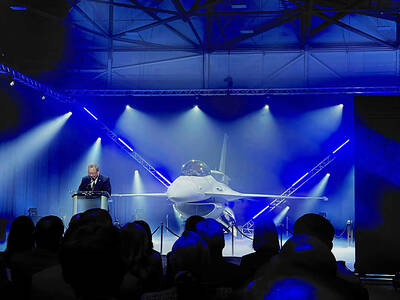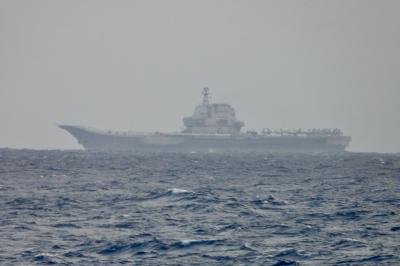Global spending on weapons now totals more than US$1.7 trillion, and Russia has overtaken Britain and France to take third place in the world league table, according to research figures released yesterday.
While military expenditure fell last year in most Western countries, including the US, which is facing serious budget deficits, Russia and China have continued to increase their spending on weapons — by more than 9 percent and 6 percent respectively last year, according to the Stockholm International Peace Research Institute (SIPRI).
The US remains by far the biggest military spender, with a defense budget of US$711 billion last year, followed by China, which spent an estimated US$143 billion on its armed forces last year. China has increased its military spending by 170 percent in real terms since 2002, the leading research body says.
Russia spent nearly US$72 billion on arms last year, overtaking Britain (US$62.7 billion) and France (US$62.5 billion) according to the institute. It says Russia is planning further increases, with draft budgets showing a 53 percent rise in real terms up to 2014.
Russia’s growing expenditure was mainly driven by the country’s aim to replace 70 percent of its Soviet-era military equipment with modern weaponry by 2020, SIPRI said, adding that it expects the Kremlin to increase its military spending in coming years.
”They are clearly putting very high priority on building up their military power again,” said Sam Perlo-Freeman, head of SIPRI’s Military Expenditure Project.
He said Russia lacks important modern communications technology for the battlefield and wants to hedge against the US’ overwhelming military might even if there is no current hostility between Russia and NATO.
However, SIPRI adds that many analysts are doubtful whether the industry will be able to carry out such ambitious plans after decades of stagnation after the collapse of the Soviet Union.
China’s increased military spending has caused concern among its neighbors and the US. The recent announcement of a US “pivot” toward Asia is in part the response to such concerns, SIPRI says.
“China’s extensive and growing trade relations with the countries in its neighborhood have been marred by disputes — eg the border dispute with India, a dispute over the Senkaku [Diaoyutai (釣魚台)] Islands with Japan, and contested maritime borders with several nations in the South China Sea — all of which have led to increased tensions,” it says.
Chinese military technology still lags behind the US’, SIPRI said.
“The US is still going to maintain for the foreseeable future overwhelming military dominance,” Perlo-Freeman said. “The US still outspends China five to one, and Russia’s spending is half of China’s.”
However, the report says talk of an arms race in the region may be premature, as both data and analysis reveal a mixed pattern of trends in military expenditure and arms acquisition, with China far from being the only driving factor.
Additional reporting by AP

US President Donald Trump yesterday announced sweeping "reciprocal tariffs" on US trading partners, including a 32 percent tax on goods from Taiwan that is set to take effect on Wednesday. At a Rose Garden event, Trump declared a 10 percent baseline tax on imports from all countries, with the White House saying it would take effect on Saturday. Countries with larger trade surpluses with the US would face higher duties beginning on Wednesday, including Taiwan (32 percent), China (34 percent), Japan (24 percent), South Korea (25 percent), Vietnam (46 percent) and Thailand (36 percent). Canada and Mexico, the two largest US trading

AIR SUPPORT: The Ministry of National Defense thanked the US for the delivery, adding that it was an indicator of the White House’s commitment to the Taiwan Relations Act Deputy Minister of National Defense Po Horng-huei (柏鴻輝) and Representative to the US Alexander Yui on Friday attended a delivery ceremony for the first of Taiwan’s long-awaited 66 F-16C/D Block 70 jets at a Lockheed Martin Corp factory in Greenville, South Carolina. “We are so proud to be the global home of the F-16 and to support Taiwan’s air defense capabilities,” US Representative William Timmons wrote on X, alongside a photograph of Taiwanese and US officials at the event. The F-16C/D Block 70 jets Taiwan ordered have the same capabilities as aircraft that had been upgraded to F-16Vs. The batch of Lockheed Martin

GRIDLOCK: The National Fire Agency’s Special Search and Rescue team is on standby to travel to the countries to help out with the rescue effort A powerful earthquake rocked Myanmar and neighboring Thailand yesterday, killing at least three people in Bangkok and burying dozens when a high-rise building under construction collapsed. Footage shared on social media from Myanmar’s second-largest city showed widespread destruction, raising fears that many were trapped under the rubble or killed. The magnitude 7.7 earthquake, with an epicenter near Mandalay in Myanmar, struck at midday and was followed by a strong magnitude 6.4 aftershock. The extent of death, injury and destruction — especially in Myanmar, which is embroiled in a civil war and where information is tightly controlled at the best of times —

China's military today said it began joint army, navy and rocket force exercises around Taiwan to "serve as a stern warning and powerful deterrent against Taiwanese independence," calling President William Lai (賴清德) a "parasite." The exercises come after Lai called Beijing a "foreign hostile force" last month. More than 10 Chinese military ships approached close to Taiwan's 24 nautical mile (44.4km) contiguous zone this morning and Taiwan sent its own warships to respond, two senior Taiwanese officials said. Taiwan has not yet detected any live fire by the Chinese military so far, one of the officials said. The drills took place after US Secretary